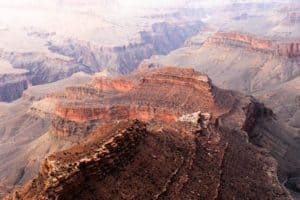We’ve discussed the use of land exchanges that would facilitate the growth of urban areas by giving them more private land in logical growth areas using the example of Las Vegas. At a different scale, the town of Tusayan appears to be an inholding in the Kaibab National Forest, which limits its growth opportunities. They have been looking at a proposal to develop a nearby separate inholding (which the town owns a part of). It would require a special use permit to for roads and utilities to cross national forest lands. It has been controversial (attracting unwanted attention according to the town; the 2nd Twitter link works), and the town has just approved a revised proposal, which will be submitted to the Forest Service. The Kaibab National Forest rejected the last proposal in 2016 as inconsistent with the requirements for a special use permit. Here is a part of the rationale that relates to the forest plan:
CFR 251.54(e)(l)(ii) requires that the proposed use must be consistent, or can be made consistent, with the Kaibab Forest Plan. The Forest Plan envisions management at a landscape scale by taking an “all-lands approach,” and specifies strategies to achieve the desired conditions and objectives in the Plan, including working closely with partners and across administrative boundaries to meet common objectives. The development that would be enabled by authorization of the proposed use of NFS lands could substantially and adversely affect Tribal lands and the Grand Canyon National Park.
36 CFR 251.54(e)(l)(v) provides that the proposed use must not unreasonably interfere with the use of adjacent non-National Forest System lands. The FS received written comments from the National Park Service (NPS) through the Principal Deputy Assistant Secretary of the Interior for Fish Wildlife and Parks which pointed out that potential impacts to the Outstanding Universal Value of the Grand Canyon National Park (GCNP), either from the roads that would be authorized by easement or the reasonably foreseeable development on the two private properties that would be enabled by the roads and other facilities, are of concern. The GCNP also raised concerns in a meeting regarding impacts on infrastructure that they share with the Town of Tusayan. The NPS was concerned that any activity that would result in significant increases in visitation or occupation near the Park would affect the Park’s capacity to absorb the additional use.
The first rationale is an interesting “all-lands” interpretation of its forest plan to encompass the objectives of the National Park Service and tribal lands. The second rationale stands on its own, but it also explains what those interests are. It’s not obvious that the recent modifications in the proposal are going to address these concerns, so I expect we’ll be seeing more about this. (Here is the CBD take on the original proposal.)

Jon, I thought “all lands” meant “all lands” including, it would seem towns that are surrounded by NFS land.
“The Forest Plan envisions management at a landscape scale by taking an “all-lands approach,” and specifies strategies to achieve the desired conditions and objectives in the Plan, including working closely with partners and across administrative boundaries to meet common objectives. The development that would be enabled by authorization of the proposed use of NFS lands could substantially and adversely affect Tribal lands and the Grand Canyon National Park.”
I think the argument would be that not being able to grow negatively impacts the town. So I’m not sure I would use “all lands” to privilege some neighboring landowners wishes at the expense of others.
I agree this is an interesting question. I don’t think you can carry it to the point where it would mean “do what adjacent private owners or communities want.” The idea that NFMA supports that has been rejected before. I could see drawing a line to include only federal and Indian trust lands, but it may become a slippery slope.
This sure brings back memories–or nightmares! I was acting district ranger in Tusayan in 1999 when the Regional Forester made a decision to allow for a “Las Vegas style” land exchange that would trade more than 2,000 acres of scattered private parcels in the Kaibab National Forest for close to 300 acres of FS land around Tusayan, allowing for planned development of badly needed infrastructure and tourism support for Grand Canyon National Park. You can Google USFS Canyon Forest Village decision to find some of the documents. All of the private lands just outside of GCNP, including Tusayan, originated as homesteads with no real planning. We worked for years with communities, local governments, tribal governments, NPS, etc. to fashion a proposal that truly would have accommodated inevitable growth in tourism in a way that had fewer environmental consequences than no decision. As you can imagine, there was worldwide interest and condemnation to the idea. All the best-laid plans turned to nothing when the County refused to rezone the land. It’s been a two decade battle since. The developers made good on their promise to attempt development of the two closest parcels–oddly configured bottom lands that were once considered promising for agriculture (but not really!). GCNP implemented some of their transportation improvements inside the park. There is still a lack of infrastructure to accommodate the tourists and service industry employees, with many living in the forest or commuting great distances on dangerous roads, as visitation has nearly doubled. This latest one just makes me sad that it could happen because it has none of the foresight of the original EIS, which was shepherded rather thoughtfully by Forest Supervisor Connie Frisch, who died not long after of cancer. Our national treasure National Parks will always be battled over. I hope the most sustainable and thoughtful option can happen. I just don’t know now what that might be.
Thanks for this background, Teri! It’s interesting that “worldwide interest” can be in the idea of protecting parks, and the reality of employees and their lives and safety may not be valued as highly.